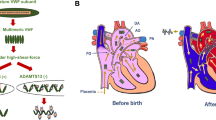Abstract
Management of hyperbilirubinemia in healthy term neonates without hemolytic disease is still a matter of concern, because of the frequency and adverse effects of phototherapy; for example mothers are separated from their infants. Recent data on bilirubin-related outcome in this group of infants, who can suffer kernicterus, intellectual and neurological impairment and sensoneural hearing impairment, justify a less aggressive management and the tolerance of higher bilirubin levels. The Berlin Neonatologists’ working group has adopted the new guidelines issued by American Academy of Pediatrics: phototherapy at a total serum bilirubin level of 340 μmol/l (20 mg/dl) at the age of > 72 h and 310 μmol/l (18 mg/dl) at the age of 48–72 h. The rate of phototherapy was thus reduced from 9.7% to 2.5%, and the rate of blood sampling from 27.1% to 14.5%.
Zusammenfassung
Das Management der Hyperbilirubinamie bei reifen gesunden Neugeborenen ohne Hamolyse ist noch immer eine Angelegenheit von Interesse wegen Haufigkeit und Nebenwirkungen der Phototherapie, wie die Trennung der Mutter von ihren Kindern. Neue Daten uber Bilirubin und das Outcome der Kinder in dieser Gruppe in bezug auf Kernikterus, intellektuelle, neurologische und Horstorungen rechtfertigen ein weniger aggressives Management und Toleranz hoherer Bilirubingrenzwerte. Die Arbeitsgemeinschaft Berliner Neonatologen schlos sich den neuen Richtlinien der ”American Academy of Pediatrics„ an, Phototherapie erfolgt ab einem Gesamtbilirubin von 340 μmol/l (20 mg/dl) im Alter von > 72 h und 310 μmol/l (18 mg/dl) im Alter von 48–72 h. Die Phototherapiehaufigkeit konnte so von 9,7 auf 2,5% und die Haufigkeit von Blutentnahmen von 27,0 auf 14,5% gesenkt werden.
Similar content being viewed by others
Literatur
American Academy of Pediatrics (1994) Practice Parameter: Management of hyperbilirubinemia in the healthy term newborn. Pediatrics 94: 558–565
Grauel EL, Obladen M, Versmold H (1994) Phototherapie bei reifen gesunden Neugeborenen ohne Hämolyse. Standard der Arbeitsgemeinschaft Berliner Neonatologen (unveröffentlicht)
Maisels MJ, Newman TB (1994) Kernikterus occurs in fullterm, healthy newborns without apparent hemolysis. Pediatr Res 35: 239 A
Newman TB, Maisels MB (1992) Evaluation and treatment of jaundice in the term newborn: A kinder, gentler approach. Pediatrics 89: 809–831
Stockhausen HB v (1993) Indikation zur Therapie eines Ikterus neonatorum. Paediatr Prax 45: 385–392
Watchko JF, Oski FA (1983) Bilirubin 20 mg/dl = Vigintiphobia. Pediatrics 71: 660–663
Versmold H, Marcinkowski M (1996) Leitlinie Hyperbilirubinämie - Phototherapie bei reifen gesunden Neugeborenen. AWMF online - Leitlinie Neonatologie/ Hyperbilirubinämie. http://www.uniduesseldorf.de/WWW/AWMF/ll/pneon-07.htm. Erscheint ausführlicher in Monatsschrift Kinderheilkunde
Author information
Authors and Affiliations
Rights and permissions
About this article
Cite this article
Versmold, H., Marcinkowski, M. Hyperbilirubinämie des reifen gesunden Neugeborenen. PerinatalMedizin 9, 33–36 (1997). https://doi.org/10.1007/s001520050046
Published:
Issue Date:
DOI: https://doi.org/10.1007/s001520050046




